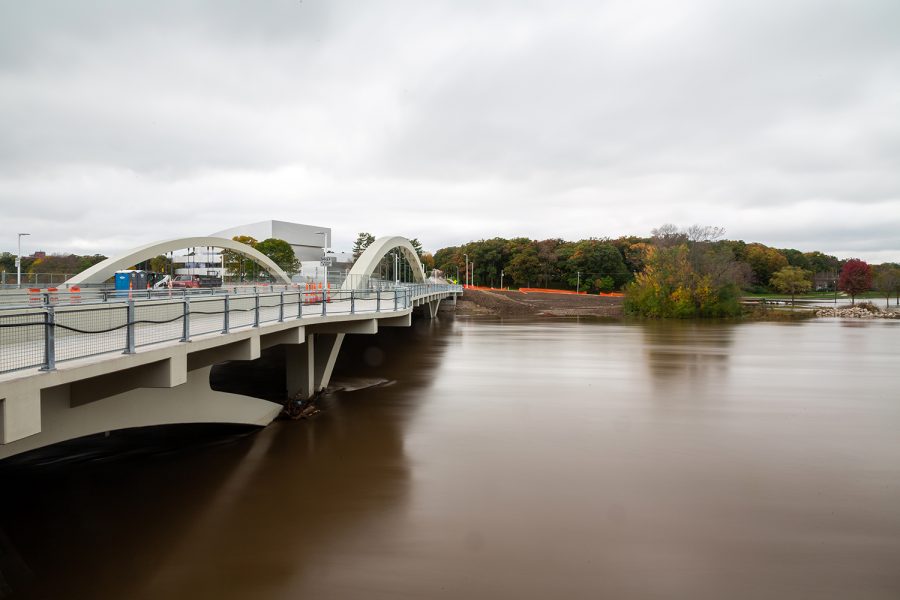Gateway Project put to the test during recent flooding
Recent flooding of the Iowa River allowed for the first chance for the city to see how well the long-anticipated Gateway Project kept Dubuque St. clear of water.
The rain-swollen Iowa river flows by the new Park Rd. Bridge and Dubuque St on Wednesday, Oct. 10, 2018.
October 11, 2018
As the city’s Gateway Project on Dubuque Street nears completion, officials have seen positive results during the recent flooding.
Over the past week, Iowa City had 6.48 inches of rain, according to the National Weather Service. A flash-flood warning was issued for the area Oct. 6, when 3.18 inches of rain fell.
The Gateway Project, Iowa City’s largest flood-mitigation effort, involved Dubuque Street, Park Road, and the Park Road Bridge. Running along the river, Dubuque Street serves as one of the main entrances to the city.
RELATED: Iowa City looks to fight flash flooding with new pump system
According the city’s website, the project raised Dubuque Street by 10 feet, 1 foot above the 100-year flood level, and rebuilt the bridge to 1 foot above the 200-year flood level.
Once complete, the project will reduce the risk of long-term closing of Dubuque Street during floods.
“It appears the project is holding up exactly like we want it to,” city engineer Jason Havel said. “With the recent flood events that we’ve had in past years, we would have likely seen impacts to Dubuque Street having to close lanes of traffic during those events. With Dubuque Street now elevated, we haven’t seen those impacts, so traffic has been able to move freely.”
RELATED: New park balances flood risk, accessibility, fun
River levels Thursday placed Iowa City around 1 foot below the 22-foot flood stage, according to the National Weather Service. Both Iowa City and the University of Iowa have taken action to prevent flood damage.
According to an update from the UI, university officials have met daily with the Army Corps of Engineers, city officials, and officials from surrounding areas to discuss the forecast and plans. The university also has an up-to-date Flood Emergency Response Plan, which it follows to ensure campus safety.
“[The plan] details the protective steps we execute building by building with each increase in river flow levels,” said Don Guckert, the UI associate vice president for Facilities Management, in the update.
Despite weather concerns, Johnson County Emergency Management Director Dave Wilson said flood-prevention efforts such as the Gateway Project are doing the job effectively and have caused the city far less trouble than in years past.
“With [the Gateway Project] in place, we’re no longer having to evacuate Mayflower,” he said. “We’re no longer having to close Dubuque Street to traffic. Everything that happened last weekend through now was as expected.”
Melissa Clow, the city special projects administrator for the engineering division, said the project was first discussed during the 1993 flood. At that time, however, the City Council determined the town would never see a flood of that magnitude again. After 2008, the plan to elevate Dubuque Street became a priority.
“If 2008 happened again [today], Dubuque Street would have to be closed for about five days, rather than the 30 that we saw at that time,” Clow said.
Ten years after the June 2008 flood, the National Weather Service said the recent conditions in Iowa City this year are unusual for the fall.
The city averages approximately 3.35 inches of rain in September, the National Weather Service said. This September, rainfall more than doubled, at 7.05 inches.
Wilson said that although numerous low-lying trails and parks near the Iowa River had to be closed down because of heavy rain, water damage in other areas have been far less substantial.
After around two-and-a-half years of construction, the Gateway Project should be finished before the end of this year, Havel said. The Park Road Bridge is complete, and it opened to traffic on Sept. 1.
“We know we will have some work in the spring, but we’re hoping it’s mostly cleanup work,” Havel said.






